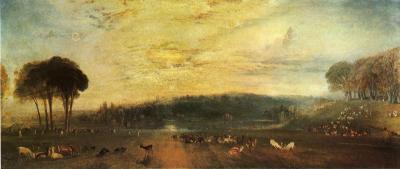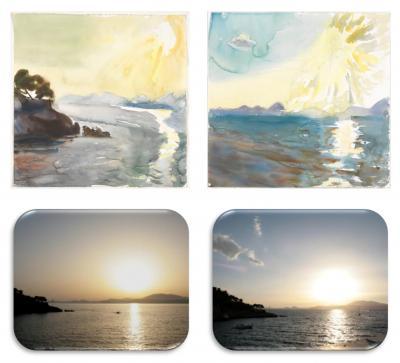Tree rings don't lie but if you trust temperature readings before 1980, you are not using a rational approach to science. There are too many cases where the official reader is a thermometer of unknown quality or a television report that used what a farmer who called in from his house said.
if you can't trust old thermometers, can you trust old paintings? A paper in Atmospheric Chemistry and Physics used the colors of sunsets painted by famous artists to estimate pollution levels in the Earth's past atmosphere. They found that the paintings reveal that ash and gas released during major volcanic eruptions scatter the different colors of sunlight, making sunsets appear more red.
When the Tambora volcano in Indonesia erupted in 1815, painters in Europe could see the colors of the sky changing. The volcanic ash and gas spewed into the atmosphere traveled the world and, as these aerosol particles scattered sunlight, they produced bright red and orange sunsets in Europe for up to three years after the eruption. J. M. W. Turner was one of the artists who painted the stunning sunsets during that time. Now, scientists are using his, and other great masters', paintings to retrieve information on the composition of the past atmosphere.

The Lake, Petworth: Sunset, Fighting Bucks (c. 1829) was one of the paintings by J. M. W. Turner analyzed by Zerefos et al. to study the past atmosphere. WikiPaintings public domain.
"Nature speaks to the hearts and souls of great artists," says lead-author Christos Zerefos, a professor of atmospheric physics at the Academy of Athens in Greece. "But we have found that, when coloring sunsets, it is the way their brains perceive greens and reds that contains important environmental information."
Zerefos and his team analyzed hundreds of high-quality digital photographs of sunset paintings done between 1500 and 2000, a period including over 50 large volcanic eruptions around the globe. They were looking to find out whether the relative amounts of red and green along the horizon of each painting could provide information on the amount of aerosols in the atmosphere.
"We found that red-to-green ratios measured in the sunsets of paintings by great masters correlate well with the amount of volcanic aerosols in the atmosphere, regardless of the painters and of the school of painting," says Zerefos.
Skies more polluted by volcanic ash scatter sunlight more, so they appear more red. Similar effects are seen with mineral (desert dust) or man-made aerosols. Air with a higher amount of aerosols has a higher 'aerosol optical depth', a parameter the team calculated using the red-to-green ratios in the paintings. They then compared these values with those given by independent proxies such as ice-core and volcanic-explosivity data, and found good agreement. The results obtained validate those of the team's previous study, published in Atmospheric Chemistry and Physics in 2007.
To further support their model, the researchers asked a famous colorist to paint sunsets during and after the passage of a Saharan dust cloud over the island of Hydra in June 2010. The painter was not aware of the dust event. The scientists then compared measurements of the aerosol optical depth made by modern instruments with those estimated from the red-to-green ratios of the paintings and of digital photographs, and found that they all matched well.

The top image shows digitally compressed paintings produced by colorist P. Tetsis at the island of Hydra in June 2010 during and after the passage of a Saharan dust cloud. The painting on the left features a more aerosol-rich scene (more dust in the atmosphere) than the one on the right. The bottom images show digital camera photos of the landscape. The pictures shown were taken half-way through the painting process. Credit: P. Tetsis (paintings) and C. Zerefos (photos)
Since aerosols scatter sunlight, less of it reaches the surface, leading to cooling. The Tambora eruption, the largest in recorded history, killed some 10,000 people directly and over 60,000 more due to the starvation and disease during the 'volcanic winter' that followed.
Aerosol optical depth can be directly used in climate models, so having estimates for this parameter helps researchers understand how aerosols have affected the Earth's climate in the past. This, in turn, can help improve predictions of future climate change.
"We wanted to provide alternative ways of exploiting the environmental information in the past atmosphere in places where, and in centuries when, instrumental measurements were not available," concludes Zerefos.
Citation: C. S. Zerefos, P. Tetsis, A. Kazantzidis, V. Amiridis, S. C. Zerefos, J. Luterbacher, K. Eleftheratos, E. Gerasopoulos, S. Kazadzis, and A. Papayannis, 'Further evidence of important environmental information content in red-to-green ratios as depicted in paintings by great masters', Atmos. Chem. Phys., 14, 2987-3015, 2014 doi:10.5194/acp-14-2987-2014




Comments